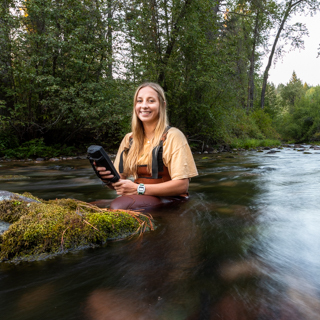Faculty
Lu Hu
Associate Professor of Environmental & Analytical Chemistry
Contact
- Office
- Chemistry 304
- Phone
- 406-243-4231
- lu.hu@mso.umt.edu
- Office Hours
By appointment
- Website
- https://www.umt.edu/atmoschem
Personal Summary
Dr. Lu Hu joined the University of Montana as an assistant professor in 2017. Before UM, Lu obtained his Ph.D. at the University of Minnesota in 2014, and then completed postdoc training at Harvard University. He went to college China University of Geosciences - Beijing and experienced serious air pollution issues. Since then he has determined to study atmospheric chemistry and contribute scientific knowledge for people to achieve and breathe clean air.
Learn more about the UM Environmental/Analytical Chemistry program
Education
Postdoctoral: Harvard University
Ph.D.: University of Minnesota – Twin Cities
Teaching Experience
CHMY 291 Chemistry of the Environment
CHMY 595 Atmospheric Chemistry (with an aircraft observation component, featured by this UM news release)
CHMY 421 Advanced Instrumental Analysis
CHMY 541 Environmental Chemistry
Research Interests
Dr. Hu's group is a joint experimental and modeling research program studying atmospheric organic chemistry and air pollution. The overarching goal is to improve understanding of the chemical composition of the atmosphere and how it is influenced by human activities and natural processes. His research group uses a combination of field observations, satellite data, and atmospheric modeling to investigate the origins, chemistry, and transport of volatile organic compounds (VOCs), and their implications for air quality and climate locally and globally. Current projects focus on global tropospheric ozone budgets, long-term changes of trace gases in the atmosphere, land-atmosphere exchange of organic carbon. More information can be found on his group website at www.umt.edu/atmoschem.
Projects
I will be accepting 1 PhD student for Fall 2024. Please see my lab website for details.
Current projects:
- Emission and chemistry of wildfires
- Factors controlling global tropospheric ozone
- Atmospheric chemistry and biogenic VOCs in the changing Arctic
Dr. Hu’s group is using high-performance computing clusters for big data analysis and global chemical transport modeling. The modeling project is to study the impacts of wildfire smoke and tropospheric ozone over the U.S. on ambient air toxics levels such as benzene, a known carcinogen.
Dr. Hu's group also carries out various field experimental projects in those sensitive areas vulnerable to enhanced air pollutants. In 2019, his group went to Alaska North Slope for a field study to investigate the influence of Arctic warming on atmospheric oxidant chemistry through anticipated increasing emissions of biogenic volatile organic compounds from the tundra. In 2018, Dr. Hu's group partnered with four other universities and NSF NCAR, and spent more than 100 hours inside a flying research aircraft to sample and study the emission and chemistry of Western U.S. wildfire plumes. One state-of-the-art instrument Dr. Hu brought to this collaborative airborne field campaign is a proton transfer reaction time-of-flight mass spectrometer, which measures the full mass spectrum of volatile organic compounds in real time at 10 Hz. These projects help answer questions like how chemical processes in fire plumes affect air quality, nutrient cycles, weather, climate and the health of millions of people exposed to smoke in the Western U.S.
Field of Study
Air quality and atmospheric chemistry; Biosphere-atmosphere interactions; Volatile organic compounds (VOCs); Ozone; Aerosol; Source attribution of air toxics; Chemical transport modeling at regional and global scales; Field observations; Mass spectrometry
Selected Publications
See http://www.umt.edu/atmoschem/ for the more recent and updated list.
Hu, L., C. A. Keller, M. S. Long, T. Sherwen, B. Auer, A. Da Silva, J. E. Nielsen, S. Pawson, M. A. Thompson, A. L. Trayanov, K. R. Travis, S. K. Grange, M. J. Evans, and D. J. Jacob (2018), Global simulation of tropospheric chemistry at 12.5 km resolution: performance and evaluation of the GEOS-Chem chemical module (v10-1) within the NASA GEOS Earth System Model (GEOS-5 ESM), Geosci. Model Dev., 11, 4603-4620, https://doi.org/10.5194/gmd-11-4603-2018.
Lu, X., L. Zhang, Y. Zhao, D. J. Jacob, Y. Hu, L. Hu, M. Gao, X. Liu, I. Petropavlovskikh, A. McClure-Begley, and R. Querel (2018), Surface and tropospheric ozone trends in the Southern Hemisphere since 1990: possible linkages to poleward expansion of the Hadley Circulation, Science Bulletin, doi:https://doi.org/10.1016/j.scib.2018.12.021.
Yan, Y., Cabrera-Perez, D., Lin, J., Pozzer, A., Hu, L., Millet, D. B., Porter, W. C., and Lelieveld, J., Global tropospheric effects of aromatic chemistry with the SAPRC-11 mechanism implemented in GEOS-Chem, Geosci. Model Dev. Discuss., https://doi.org/10.5194/gmd-2018-196.
Young, P.J., Naik, V., Fiore, A.M., Gaudel, A., Guo, J., Lin, M.Y., Neu, J., Parrish, D., Reider, H.E., Schnell, J.L., Tilmes, S., Wild, O., Zhang, L., Brandt, J., Delcloo, A., Doherty, R.M., Geels, C., Hegglin, M., Hu, L., Im, U., Kumar, R., Luhar, A., Murray, L., Plummer, D., Rodriguez, J., Saiz-Lopez, A., Schultz, M.G., Woodhouse, M., Zeng, G., Ziemke (2018), Tropospheric Ozone Assessment Report: Assessment of global-scale model performance for global and regional ozone distributions, variability, and trends, Elem. Sci. Anth., 6(1):10, doi: https://doi.org/10.1525/elementa.265.
Hu, L., D.J. Jacob, X. Liu, Y. Zhang, L. Zhang, P.S. Kim, M.P. Sulprizio, R.M. Yantosca (2017), Global budget of tropospheric ozone: evaluating recent model advances with satellite (OMI), aircraft (IAGOS), and ozonesonde observations, Atmos. Environ., 167, 323-334, doi: 10.1016/j.atmosenv.2017.08.036 [Supplement]. [Featured at NASA website for Aura Science]
Zhu, L., L. J. Mickley, D. J. Jacob, E. A. Marais, J. Sheng, L. Hu, G. González Abad, and K. Chance (2017), Long-term (2005–2014) trends in formaldehyde (HCHO) columns across North America as seen by the OMI satellite instrument: Evidence of changing emissions of volatile organic compounds, Geophys. Res. Lett., 44, 7079–7086, doi:10.1002/2017GL073859 [Supplement].
Weimer, M., J. Schröter, J. Eckstein, K. Deetz, M. Neumaier, G. Fischbeck, L. Hu, D.B. Millet, D. Rieger, H. Vogel, B. Vogel, T. Reddmann, O. Kirner, R. Ruhnke, and P. Braesicke (2017), An emission module for ICON-ART 2.0: Implementation and simulations of acetone, Geosci. Model Dev., 10, 2471-2494, https://doi.org/10.5194/gmd-10-2471-2017 [Supplement].
Millet, D. B., M. Baasandorj, L. Hu, D. Mitroo, J. Turner, B. J. Williams (2016), Nighttime chemistry and morning isoprene can drive daytime ozone downwind of a major deciduous forest, Environ. Sci. Technol., 50, 4335-4342, doi:10.1021/acs.est.5b06367 [Supplement].
Schmidt, J. A., D. J. Jacob, H. Horowitz, L. Hu, T. Sherwen, M. Evans, Q. Liang, R. Suleiman, D. Oram, M. Le Breton, C. Parcival, S. Wang, B. Dix, and R. Volkamer (2016), Modeling the observed tropospheric BrO background: Importance of multiphase chemistry and implications for ozone, OH, and mercury, J. Geophys. Res. 121, 11819–11835, doi:10.1002/2015JD024229 [Supplement].
Yan, Y.-Y., J.-T. Lin, J. Chen, L. Hu (2016), Improved simulation of tropospheric ozone by a global-multi-regional two-way coupling model system, Atmos. Chem. Phys., 16, 2381-2400, doi:10.5194/acp-16-2381-2016.
Hu, L., D.B. Millet, M. Baasandorj, T.J. Griffis, K.R. Travis, C. Tessum, J. Marshall, W.F. Reinhart, T. Mikoviny, M. Müller, A. Wisthaler, M. Graus, C. Warneke, and J. de Gouw (2015a), Emissions of C6-C8 aromatic compounds in the United States: Constraints from tall tower and aircraft measurements, J. Geophys. Res., 120, 826-842, doi:10.1002/2014JD022627 [Supplement]. [Highlighted on the cover of the JGR-Atmosphere]
Hu, L., D.B. Millet, M. Baasandorj, T.J. Griffis, P. Turner, D. Helmig, A.J. Curtis, J. Hueber (2015b), Isoprene emissions and impacts over an ecological transition region in the US Upper Midwest inferred from tall tower measurements, J. Geophys. Res., 120, 3553-3571, doi:10.1002/2014JD022732 [Supplement].
Baasandorj, M., D.B. Millet, L. Hu, D. Mitroo, and B.J. Williams (2015), Measuring acetic and formic acid by Proton Transfer Reaction-Mass Spectrometry: Sensitivity, humidity dependence, and quantifying interferences, Atmos. Meas. Tech., 8, 1301-1321.
Millet, D.B., M. Baasandorj, D.K. Farmer, J.A. Thornton, K. Baumann, P. Brophy, S. Chaliyakunnel, J.A. de Gouw, M. Graus, L. Hu, A. Koss, B.H. Lee, F.D. Lopez-Hilfiker, J.A. Neuman, F. Paulot, J. Peischl, I.B. Pollack, T.B. Ryerson, C. Warneke, B.J. Williams, and J. Xu (2015), A large and ubiquitous source of atmospheric formic acid, Atmos. Chem. Phys., 15, 6283-6304.

